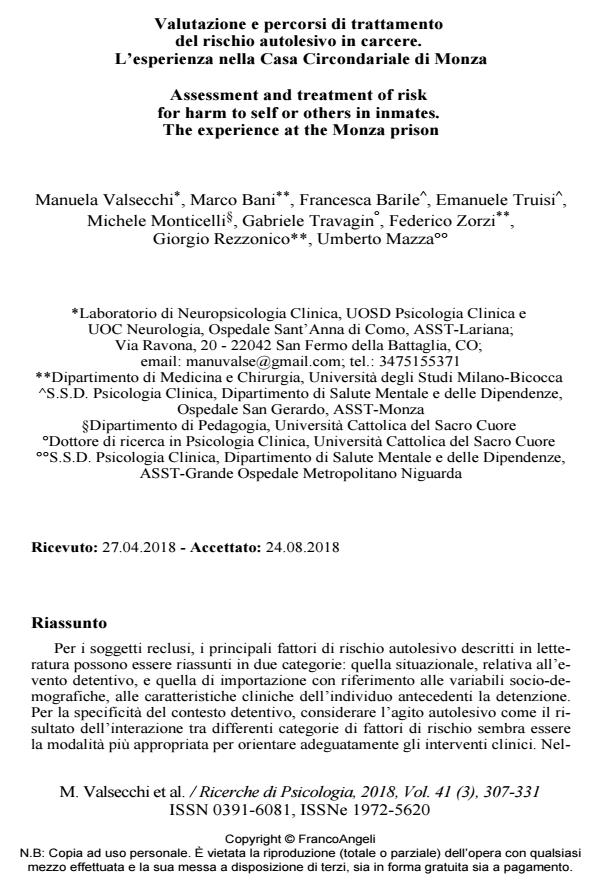Valutazione e percorsi di trattamento del rischio autolesivo in carcere. L’esperienza nella Casa Circondariale di Monza
Titolo Rivista RICERCHE DI PSICOLOGIA
Autori/Curatori Manuela Valsecchi, Marco Bani, Francesca Barile, Emanuele Truisi, Michele Monticelli, Gabriele Travagin, Federico Zorzi, Giorgio Rezzonico, Umberto Mazza
Anno di pubblicazione 2018 Fascicolo 2018/3
Lingua Italiano Numero pagine 25 P. 307-331 Dimensione file 90 KB
DOI 10.3280/RIP2018-003002
Il DOI è il codice a barre della proprietà intellettuale: per saperne di più
clicca qui
Qui sotto puoi vedere in anteprima la prima pagina di questo articolo.
Se questo articolo ti interessa, lo puoi acquistare (e scaricare in formato pdf) seguendo le facili indicazioni per acquistare il download credit. Acquista Download Credits per scaricare questo Articolo in formato PDF

FrancoAngeli è membro della Publishers International Linking Association, Inc (PILA)associazione indipendente e non profit per facilitare (attraverso i servizi tecnologici implementati da CrossRef.org) l’accesso degli studiosi ai contenuti digitali nelle pubblicazioni professionali e scientifiche
Per i soggetti reclusi, i principali fattori di rischio autolesivo descritti in letteratura possono essere riassunti in due categorie: quella situazionale, relativa all’evento detentivo, e quella di importazione con riferimento alle variabili socio-demografiche, alle caratteristiche cliniche dell’individuo antecedenti la detenzione. Per la specificità del contesto detentivo, considerare l’agito autolesivo come il risultato dell’interazione tra differenti categorie di fattori di rischio sembra essere la modalità più appropriata per orientare adeguatamente gli interventi clinici. Nella Casa Circondariale di Monza, dal settembre 2012, viene applicato un protocollo finalizzato alla prevenzione dell’agito auto/etero lesivo, a tutta la popolazione che accede in istituto entro 72 ore dall’ingresso al Servizio Nuovi Giunti. Oltre al colloquio clinico, viene somministrato un assessment testale, finalizzato ad un esame multidimensionale, con i seguenti strumenti standardizzati sulla popolazione detenuta: i) Jail Screening Assessment Tool (J-Sat), intervista semistrutturata che permette di indagare la situazione giuridica (tipo di reato, detenzioni), anamnesi degli agiti aggressivi (auto/etero diretti), valutazione psicosociale (relazioni significative, supporto sociale, lavoro), uso di sostanze, presenza di disturbo psichiatrico (in anamnesi e nell’attualità), rischio suicidario/autolesivo, presenza di sintomatologia ansiosa e depressiva; ii) Barratt Impulsiveness Scale 11 (BIS11) scala autosomministrata mirata alla misurazione dell’impulsività; iii) Clinical Outcome in Routine Evaluation-Outcome Measure (CORE-OM), scala autosomministrata che permette di valutare il livello del distress psicologico, utilizzata anche come strumento di valutazione d’esito dell’intervento attivato. In caso di positività allo screening, avviene l’assunzione in cura del detenuto valutando l’evoluzione del quadro clinico, si procede alla richiesta di valutazione psichiatrica ed all’inserimento in un piano di monitoraggio, con misure di sorveglianza a carattere precauzionale. Entro 2 settimane dal primo colloquio, viene somministrato il Millon Clinical Multiaxial Inventory-III (MCM-III), questionario finalizzato ad approfondire la struttura ed il funzionamento della personalità. Il protocollo di valutazione utilizzato consente di indagare, sia i fattori situazionali sia quelli di importazione come categorie di rischio, oltre che la loro interazione, su questa base il clinico procede alla definizione dell’intervento più appropriato. La fase di valutazione iniziale permette di identificare le aree di fragilità da affrontare e di definire gli obiettivi dell’intervento, condividendoli con il paziente detenuto.
Parole chiave:Agiti auto/etero lesivi, detenuti, fattori di importazione, fattori situazionali, trattamento clinico.
- Stili di personalità e definizione dei percorsi di cura per pazienti detenuti attraverso l'inventario di Millon Emanuele Truisia, Marco Bani, Francesca Barile, Manuela Valsecchi, Federica Corbetta, Giorgio Rezzonico, Umberto Mazza, in RICERCHE DI PSICOLOGIA 3/2018 pp.353
DOI: 10.3280/RIP2018-003004
Manuela Valsecchi, Marco Bani, Francesca Barile, Emanuele Truisi, Michele Monticelli, Gabriele Travagin, Federico Zorzi, Giorgio Rezzonico, Umberto Mazza, Valutazione e percorsi di trattamento del rischio autolesivo in carcere. L’esperienza nella Casa Circondariale di Monza in "RICERCHE DI PSICOLOGIA " 3/2018, pp 307-331, DOI: 10.3280/RIP2018-003002